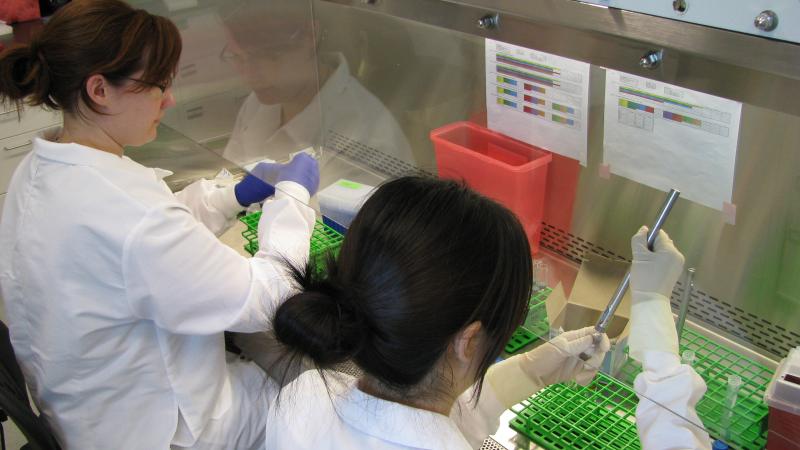Analysis shows that scientists change their research interest in patterns with three distinctive features
May 3, 2017

The scientist who ventures away from her original research interest is far rarer than those who stay in familiar territory, according to new research in the emerging field of “the science of research science” published in Nature Human Behavior. The quantitative analysis reveals three key patterns: few scientists move away from their original research focus, those who move do so gradually, and even new interests tend to incorporate favored topics from earlier in their career.
“In science there is room for people who focus their whole life in one direction, and for those who move into different areas. And yet, not surprisingly, the larger the extent of change over their career, the smaller the percentage of people who are doing it,” said Boleslaw Szymanski, the senior author of the research and director of the Network Science and Technology (NeST) Center at Rensselaer Polytechnic Institute.
The science of research science seeks to better understand the scientific enterprise, improving the quality of results and the pace of innovation.
“There are enormous challenges to overcome for scientists to move between disciplines. With this work, we can begin to identify the barriers, and work to better manage science and the direction of innovation,” said Szymanski, the Claire and Roland Schmitt Distinguished Professor of Computer Science at Rensselaer.
To track research interests over time, Szymanski and his co-authors looked at research articles published in American Physical Society (APS) journals over 30 years, a collection that included 14,715 scientists, each of whom published more than 16 papers, for a total of about 500,000 articles. Each article included topical tags from the Physics and Astronomy Classification Scheme, which identifies 10 main topics and 67 areas within those topics. Authors tag each article with a topic and as many areas as they choose, but on average there are three tags per paper. In the analysis, Szymanski and his team chose the first three tags, creating an ordered list, or “topic tuple,” that represented the research interests of the author at the time of publication.
With this information, the team was able to track the extent to which research interests shifted over the course of a career and how quickly they shifted, and prepared a model to depict that shift.
The analysis showed that most scientists retained remarkably homogenous research interests throughout the course of their career. In choosing topics, scientists are more likely to select more recently used topics than those used long ago. And changing interests tend to happen gradually, with more elements of a new topic preserved than replaced. Looking at the frequency with which topics appear in a publication sequence, the analysis found that a small number of topics appear frequently while most subjects appear only a few times, a pattern described mathematically with a “power law distribution.”
While scientists who strayed far from their original research focus were rare, they were equally as productive as those who stayed close to home.
The team also created a series of models to test assumptions about changes in research interest, and found that the changes in research interest were best modeled by an unbiased random walk along a line of topics, with an equal chance for a scientist to move away from or back to the starting point. Also, scientists who shifted interest over time did so gradually, with more elements in a given topic tuple preserved than changed at each point.
“Quantifying patterns of research-interest evolution” can be found using DOI:10.1038/s41562-017-0078. Szymanski was joined in the research by Tao Jia, a former postdoctoral research associate in the NeST Center who is now on the faculty of Southwest University in Chongqing, China, and Dashun Wang of Northwestern University.
Szymanski’s research is enabled by the vision of The New Polytechnic, an emerging paradigm for higher education which recognizes that global challenges and opportunities are so great they cannot be adequately addressed by even the most talented person working alone. Rensselaer serves as a crossroads for collaboration — working with partners across disciplines, sectors, and geographic regions — to address complex global challenges, using the most advanced tools and technologies, many of which are developed at Rensselaer. Research at Rensselaer addresses some of the world’s most pressing technological challenges — from energy security and sustainable development to biotechnology and human health. The New Polytechnic is transformative in the global impact of research, in its innovative pedagogy, and in the lives of students at Rensselaer.
About Rensselaer Polytechnic Institute
Rensselaer Polytechnic Institute, founded in 1824, is America’s first technological research university. For nearly 200 years, Rensselaer has been defining the scientific and technological advances of our world. Rensselaer faculty and alumni represent 85 members of the National Academy of Engineering, 17 members of the National Academy of Sciences, 25 members of the American Academy of Arts and Sciences, 8 members of the National Academy of Medicine, 8 members of the National Academy of Inventors, and 5 members of the National Inventors Hall of Fame, as well as 6 National Medal of Technology winners, 5 National Medal of Science winners, and a Nobel Prize winner in Physics. With 7,000 students and nearly 100,000 living alumni, Rensselaer is addressing the global challenges facing the 21st century—to change lives, to advance society, and to change the world. To learn more, go to www.rpi.edu.